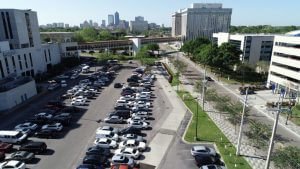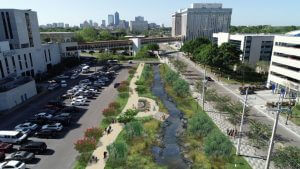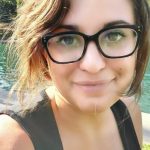Gloria McNair
Jacksonville, Florida
Gloria McNair has admired the environmental work of Groundwork Jacksonville since the organization began. Now, as Manager of Community Engagement and Equity Initiatives, she engages the citizens — especially residents from historically underserved urban neighborhoods — in visioning, advocating for and shaping Groundwork projects including McCoys Creek restoration and building the Emerald Trail.
Gloria’s professional career has been diverse, yet at the core of her work has been a dedication to service. She joined the U.S. Navy and served 22 years of active service, first as a Hospital Corpsman and then as an Environmental Health Officer. After retiring in Jacksonville, she used her skills as an educator and preventive health advocate with the Florida Department of Health in Duval to support initiatives such as the Green Team’s community garden. Gloria has a MA in Human Resource Development from Webster University, a Bachelor of Science degree in Psychology from Excelsior and an Associates of Science degree in Environmental Health from Merritt College. Originally from South Carolina, Gloria now proudly claims Jacksonville as home for her and her husband and two daughters.
This interview was conducted by Carly Schmidt on August 7, 2021. Learn more about Gloria’s work at groundworkjacksonville.org.
What was your first introduction to Groundwork Jacksonville in the community?
I became aware of Groundwork Jacksonville when I was at the Florida Department of Health and we had a grant working with the Green Team. I thought wow, this is such an awesome organization, and was excited by the opportunity to work with them. When I was first introduced to them, we were working with several organizations, including the Green Team, to develop school and community gardens. They were just wonderful kids who now had the opportunity to engage in activities that they normally wouldn’t, like gardening and kayaking. It was wonderful to watch them get their hands dirty and also how mentorship was developing their skills as future leaders.
How have you seen the organization evolve and what are your priorities now?
It has expanded so much! Groundwork Jacksonville has grown exponentially. Kay Ehas is driving this growth as our CEO and almost everything we’re doing revolves around the Emerald Trail project, which will result in 30 miles of new and existing greenway through 14 historic neighborhoods. It will generate economic development and connect the urban core communities around their waters, which is just so exciting.
As the community engagement coordinator, what is your role in this project?
My role is talking and coordinating with these communities; asking about their dreams and hopes for their neighborhoods. There are two creeks along the trailway, and we like to call them the “gems of the trail”, but they’ve been contaminated and plagued by flooding. We tackled the McCoys Creek restoration project first, so I focused on the nearby North Riverside and Brooklyn communities that were connected to the creek.
McCoys Creek floods often. Even with a little bit of rain, the floods damage property and people can’t access their homes or the roads. This was an area that was redlined and very little investment has gone into this community until this project. The community is generally happy to see it, but they’re worried about displacement, as we all are. They are concerned about folks coming in and buying property and losing their place in the community as a result. To address their concerns, we started equity planning with the community. We worked with them to identify their concerns and develop a visioning statement and action plan for the community.
We identified four areas of concern. Housing is the highest priority concern due to ongoing displacement. Home repair and renters to homeowners programs are now being discussed and planned with community partners. Another area of concern was economic development. Residents want more small business and job training opportunities. I was particularly excited about the environmental stewardship priority, as well as cultural preservation within the community.
How did the community respond to this outreach?
Responses to our outreach have been mixed and many community members are skeptical. Promises had been made to these people in the past by organizations and local governments, but they never happened. They definitely wanted something done about the flooding, but they were really unsure about us. We held engagement meetings in the community, walked through the neighborhoods and talked to people, and tried to explain what the McCoys Creek restoration was all about while also asking about their goals and letting them know that they have a voice. This McCoys Creek project is now under construction. It’s been almost three years in the making, so it’s a major accomplishment to see that work in motion.
Still, not everyone is completely satisfied. This is a huge project that requires road closure to restore the natural meandering creek. But this is what we need to do to manage flooding in the long-term. I find that the younger generation thinks that the project is a very good thing. They have young children and they want them to go outside and feel safe when they play. The older generation has been more skeptical.
Now that McCoys Creek restoration is underway, what are you focused on now?
We have moved on the Hogans Creek restoration project; specifically, the community engagement and visioning stage of the project. It’s a lot of good and rewarding work. Groundwork also has a Watershed Project that includes McCoys Creek and Hogans Creek, and community engagement planning is underway. The first model mile of the Emerald Trail , also referred to as the LaVilla Link, breaks ground next month!


Hogans Creek before and after the restoration project from Groundwork Jacksonville.
It really sounds like you don’t further an initiative without going to the community first. Is that correct?
You got it. This is the way we will plan to continue the work. We were so excited when funding became available through River Network’s community-led research program. We initially applied for the funding because we wanted to improve on that part of our work: getting feedback from the community, canvassing, and surveying to determine their needs and vision for their community. April and the River Network team were so helpful when we were developing a survey for the Hogans Creek project and I am so grateful for them and this partnership.
How do you maintain community engagement throughout a long-term, collaborative project?
Consistency is a big part of it, as well as honoring your word. When you say that you’re going to do something or include them in a decision, they need to see action from what you produce and they need to see that their input is there. For example, when we started Community Restoration Environmental Stewardship Training (CREST), we made sure that the community saw their own faces in our quarterly newsletter. I like to think that Groundwork’s sincerity and others’ connection to their community encouraged other people to get involved.
But each community is different. CREST came out of the McCoys Creek project. Hogans Creek involves three different types of communities: a Cathedral district, a developing district, and a redlined district that is primarily African American. We’re encouraging these communities to connect with each other in order to prosper a little bit more. I attend their meetings. I sit and talk with the residents, as well as others as they pass by, and think, “these Groundwork people are serious. They really want to get to know us.” You have to be consistent in showing up and showing them that you value their input.
You’ve painted a picture for us about what constitutes effective community engagement. What makes you uniquely positioned for this kind of role and how did you come into this work?
Most of my career has been in the realm of public health. I am a retired Navy lieutenant and I ran preventative medicine, which meant lots of education. When I was on active duty, I was teaching people everything from STDs to immunizations to food safety. It was a natural fit and I always felt that I was doing it for the troops. When I retired, I ended up doing very similar work. I realized that my life’s work wasn’t specific to the military or any specific region. I wanted to help people who needed education, support, or someone to advocate for them. This position with Groundwork Jacksonville as their community engagement coordinator was a natural fit once again. I like people and I like getting them the information that they need in order to thrive.
Groundwork Jacksonville is really about uplifting communities and building resiliency. We share the same hope that all of us can have the same, equitable beginning in life and the same access to the good life.







